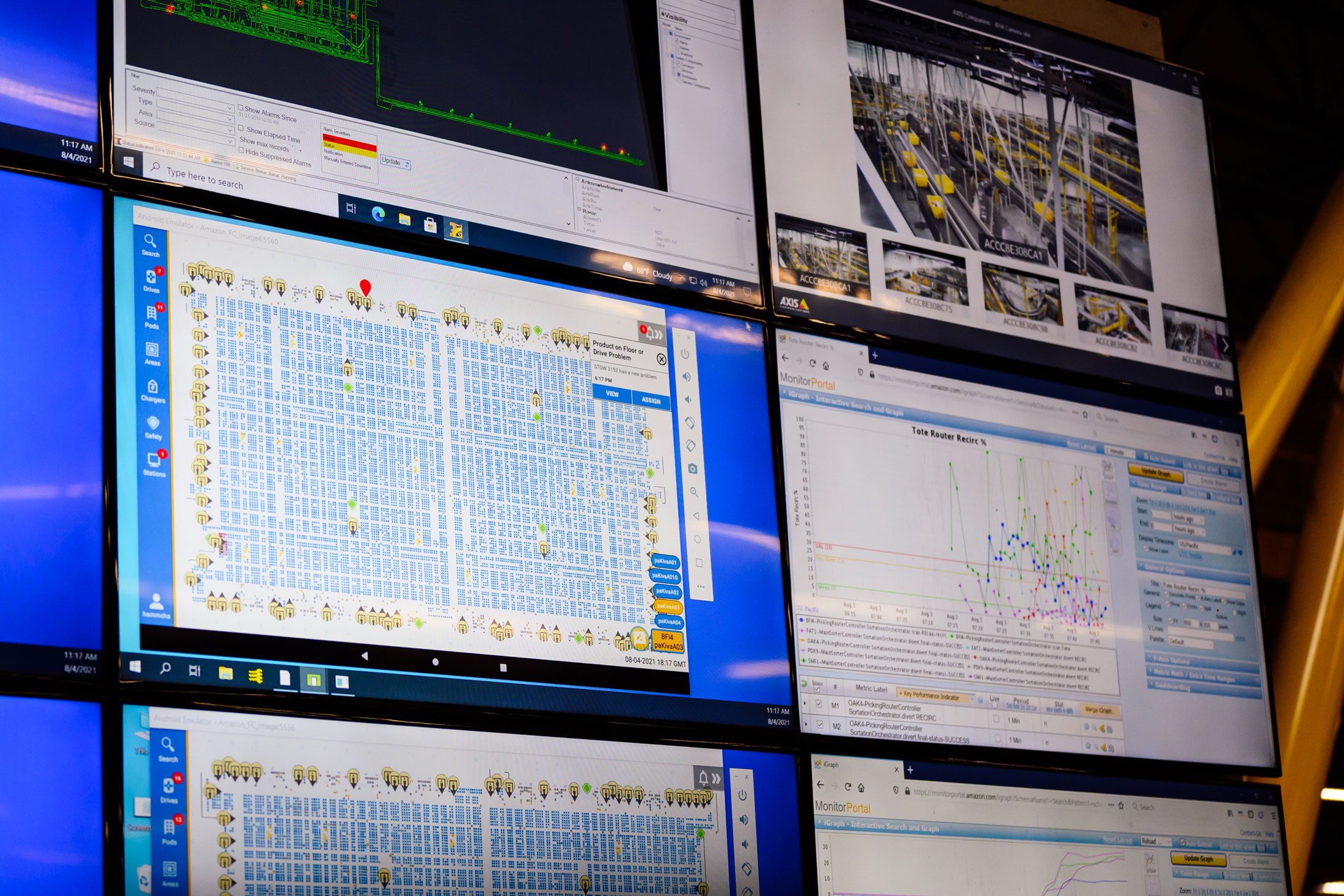
Digital Solutions
and Specialized Software
for Value Chains
Software is the Magic!
Warehouse Automation: How a Software-First Approach Optimizes Efficiency
As warehouses become increasingly more digitized, it's important to build a robust software foundation in order to more successfully integrate the new automation technologies that will continue to optimize workflows.
The most important resource in any warehouse is data. It gives you a valuable assessment of the current functions in your warehouse and where to go from there. Without the right systems in place to gather the information, however, valuable data goes to waste, leaving warehouse operators to make uninformed decisions.
Until recently, warehouse automation was commonly thought of as installing a hardware system and then leaving it in place and untouched for several years. This isn’t the case anymore, as companies who truly "win" with automation, whether software or hardware, are those that take small, short-term steps with technology, then rapidly innovate and iterate.
But how do you lay the proper groundwork for automation success?
As warehouses become increasingly more digitized, it's important to build a robust software foundation in order to more successfully integrate the new automation technologies that will continue to optimize workflows.
Introducing Digitization
In general, automation begins with the same problem statement – a lack of data digitization, which is needed to execute automation in warehouse facilities.
The vast majority of warehouses in the United States are still paper based, maybe using Microsoft Excel, for example, to track inventory. Because of this, a good first step for companies seeking to automate is to bring in inventory tracking software such as a Warehouse Management System (WMS). This kind of solution helps control inventory, manage order demand and streamline facility work.
What makes WMS technology an easy go-to for entry to automation is that it’s already a proven solution. In essence, the WMS enables a warehouse to establish its “digital data backbone” by leveraging digitization and access to relevant data. This allows warehouse operators to then optimize their execution, because now they have a foundation allowing them to receive insights about the health and efficiency of their facilities and use those insights as a decision-making tool.
After implementing a WMS, the next step in introducing warehouse digitization is to look at how inventory throughput and accuracy can be increased. To achieve this, complementary technology should be brought in. Many companies assume that can only mean robots, but that may not be the case in every situation. Sometimes, the solution may be as simple as introducing a voice-based picking technology, such as a headset that informs employees of which products to retrieve, how to collect them and where they need to go.
Another option that can be implemented prior to highly sophisticated software or hardware solutions is providing multilingual support to staff. No matter where your warehouse is in the world, such support can immediately accelerate time to value for all employees by increasing accuracy and consistency in execution to achieve greater facility throughput.
Once these types of easy, software-based steps have been accomplished, warehouse operators will have better throughput visibility throughout their facility and can deploy additional technologies that maximize overall efficiency and employee success.
Preparing for Tomorrow
Beginning with digitization in your warehouse can be reflected in a “crawl-walk-run” approach to automation and defined success. Digitization as a starting point makes it possible for there to be no untracked work or inventory in a facility; there’s full traceability into the workflows and efficiencies operating throughout the warehouse.
That data also provides the clarity you need to then create a brokerage of information between your current technologies and additional hardware or software you are ready to deploy. Availability of data is paramount to the certainty that every system in the warehouse can be optimized by the other systems.
Seamless integration across existing and new solutions is also key. Reflecting this trend, more companies are moving away from their homegrown WMS and towards well known sustainable platforms that have proven technology and easy interoperability with other technologies in the space.
Lastly, it would be a disservice not to address artificial intelligence (AI) as the near future and “run” portion of automation. AI software definitely has its place in everything supply chain and logistics and will become increasingly important to automation. However, warehouse operators should keep in mind that the technology is only as good as the model of data given to it. It's tempting to run AI solutions immediately, but the technology is most effective when given large data sets to iterate upon. Digitization of data, regardless of whether it’s inventory or labor, entered into an AI model can help it make more intelligent suggestions and provide optimization opportunities.
But those days are yet to come. For the short-term, AI will help operators understand and predict the flow of their facilities more accurately and allow teams to be nimbler with their solutions. It will assist the people in the facility before it helps the machines.
Companies seeking to enter or expand automation must shift their mindset to "small wins every day." This can mean starting with the implementation of one software solution, observing its impact and then adjusting prior to introducing another technology.
The world has become increasingly reliant on technology. Warehouses that invest in digitization now will reap the benefits in years to come.
Warehouse Management System
Our flexible warehouse management system (WMS) software is delivered in the cloud or on premises, with deep, rich functionality that almost always delivers an out-of-the-box solution for large and mid-size companies.
Warehouse Control System
Our warehouse control systems orchestrates material flow within an automated fulfillment or distribution center. At its core, it effectively coordinates a number of automation and robotic components to maintain overall system throughput.
Warehouse Execution System
WES software has led the way in true waveless operation delivery, fulfilling the demands of a high velocity and variability order mix within the constraints of tight delivery requirements, while optimizing the resource utilization.
WMS vs WCS vs WES
Discover the differences between WES, WMS, and WCS. We explain the functionalities of each and help you choose the right software for your operations.
Real Time Warehouse Management
Central Brain for synchronized task management that utilizes Real-Time Location Systems and the in-motion position of all resources (AMRs, automation, and humans) to manage operations and distribute synchronized tasks.
Put Wall Optimization
What is a Put Wall? A Put Wall is a fulfillment system that uses a physical structure to create a series of “cubbie holes” or slots into which products for customer orders are placed, or put, after picking. Each slot holds products for all, or part, of an individual customer order.

Software Solutions
Data Analytics
Warehouse automation and supply-chain data science are both important areas for businesses that aim to optimize their operations and reduce costs. With the help of AI and machine learning algorithms, companies can streamline their logistics, improve their inventory management, and enhance their overall efficiency.
Automation IQ
Fulfillment centers now need to accommodate different types of fulfillment models, each with specific requirements. Multi-robot orchestration addresses these challenges by providing a platform that integrates and orchestrates the activities of various robots, enabling seamless interface, collaboration, and workflow optimization.
Warehouse IQ
Introducing the first Supply Chain Execution and Workforce Management Solution
ERP vs WMS
Organizations with specific warehouse and inventory management needs may require a warehouse management system (WMS) in addition to ERP. Augmenting ERP with WMS might offer better support of an organization's goals and provide a competitive advantage.
Warehouse Ontology
Central We simply take all the forms of data that exist across your enterprise from the documents and spreadsheets that live on your analysts’ desktops all the way up to your large enterprise grade databases and make all of those accessible from within a single unified environment. We have the ability to go up to billions of records a petabyte of data.
Software is the Magic
Automation software is highly complex and needs to be written ‘elegantly to allow for highly dynamic and flexible warehouse environments.
Intelligent software and digitalization solutions are the key building blocks of modern automation systems. The software, as integrated intelligence, networks all processes, automation technologies, and people in the warehouse and links all the steps in the supply chain.
Delivering operational efficiency within a warehouse, distribution center, or production facility
Let’s look at how Warehouse Automation can optimize operations within your facility. When considering the key KPIs, it’s easy to see the advantages.
Warehouse Automation Operate makes decisions in real-time throughout the facility. For example, it uses continuous flow order release methodologies to cut cycle time for critical orders. If an order is urgent, the software can instantly make it a priority and a holistic integration (from order management through to machine operation) allows the priority order to be fulfilled as quickly as possible.
The software also provides advanced reporting and analytics to help you make informed and insightful decisions. Once in place, Warehouse Automation software solutions increases throughput and reduces operational costs using these and other optimization features.
